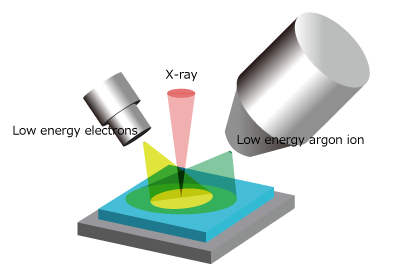
Horiba EMIA-Pro Carbon/Sulfur Analyzer – Sigmatech Inc. Philippines
The EMIA-Pro Carbon/Sulfur Analyzer is based on HORIBA’s widely respected expertise in Non-Dispersive Infrared (NDIR) technology.

Since its launch, the VersaProbe series has been one of the most widely used XPS instruments around the world. With the improved analyzer and input lens, the VersaProbe III has achieved three times as high sensitivity as conventional technologies, enabling even higher throughput and the best possible micro XPS analysis.
The VersaProbe III employs a 32-channel electrostatic hemispherical electronic analyzer and an analyzer that uses a highly sensitive input lens system, achieving three times as high sensitivity analysis as our conventional technologies. Combined with a high brightness scanning micro x-ray source, high performance micro-area analysis is substantialized.
The SXI (scanning x-ray image) is an image of photoelectrons, excited by micro focus x-ray, taken into the electronic analyzer.The photoelectron image is produced by the same x-ray used in actual analysis which enables accurate analysis location quickly and easily.

Figure 1. Analysis of faulty Au electrode wire bonding
XPS is used to analyze the composition and bonding state of the solid surface of a wide range of materials from conductors to insulators, but the need to set charge neutralization conditions for insulators has been an impediment to automated analysis.
The VersaProbe III resolved this problem by simultaneous irradiation of a low-energy electron beam and an ion beam. This technology now allows turnkey measurement of insulators without burdensome adjustments, enabling overnight automated analysis of conductors and also insulators.

Figure 2. Schematic diagram of charge neutralization
through dual beam irradiation
The SmartSoft software displays observation data (such as intro photos, SXI, and photos taken by a live view camera) and measurement data (such as spectra, profiles, and maps) on the same screen. Specifying an analysis location on the intro photo moves the stage to that location.
In addition, the automatic height adjustment function (Auto-Z) and SXI can easily and accurately define the analysis position where you want to analyze.
Turnkey dual beam charge neutralization and accurate alignment by Auto-Z allow for reliable automatic measurement, improving analysis work efficiency and providing highly reproducible analysis results.

Figure 3. SmartSoft screen showing measurement results
The PHI VersaProbe III has not only achieved micro XPS analysis with three times as high sensitivity as conventional technologies but it has also enabled XPS with the ultimate of depth resolution by introducing an angle resolution mode and low energy argon sputtering.
As shown in Figure 4, in the conventional micro analysis, the solid angle range in which photoelectrons are captured is as large as +/- 20 degrees, which made it difficult to analyze only the outmost surface. In the new angle resolution mode of narrow solid angle range of +/- 5 degrees allows analysis based only on information on the outermost surface. In addition, the introduction of a new argon gas cluster ion gun (Ar-GCIB) now allows sputtering with extremely low energy of 1 keV.

Figure 4. Schematic diagrams of two different analysis modes that capture photoelectrons in different solid angle ranges
Figure 5 shows the results of a depth profile analysis of a film made of layers of Irganox1010, which is commonly used as a plastic additive, and layers of Irganox3114 formed between the Irganox1010 layers in a delta like shape.
While carbon and oxygen are contained in both Irganox1010 (C73H107O12) and Irganox3114 (C33H46N3O5 ), nitrogen is contained only in Irganox3114. This can be seen in the detection result of nitrogen represented by delta shapes.
The extremely low energy Ar-GCIB achieves even higher depth resolution.

Figure 5. Results of depth profile analysis of a multi-layer film of Irganox

Figure 6. Overhead view of the instrument
Brochures

The EMIA-Pro Carbon/Sulfur Analyzer is based on HORIBA’s widely respected expertise in Non-Dispersive Infrared (NDIR) technology.


The Q300T T Plus is a large chamber, turbo-pumped coating system, ideally suited for sputtering a single large diameter specimen up to 8″/200mm or multiple smaller specimens over a similar diameter.


The Analyte Excite+ is the ultimate excimer based laser ablation system. It utilizes the latest, highly developed iteration of ATL’s solid-state switched laser engine and includes the acclaimed HelEx II Active 2-Volume Ablation Cell and its unique adaptive inner cell.

With the 360 ES series Precision balances, Precisa is setting new standards: innovative, high-tech instrumentation which includes the latest technical developments, unique performance features, best user-interface and the most modern design to establish the 360 ES series as the very bench-mark for modern laboratory technology.
You may contact our specialists by accomplishing form below.
You may contact our specialists by accomplishing form below.